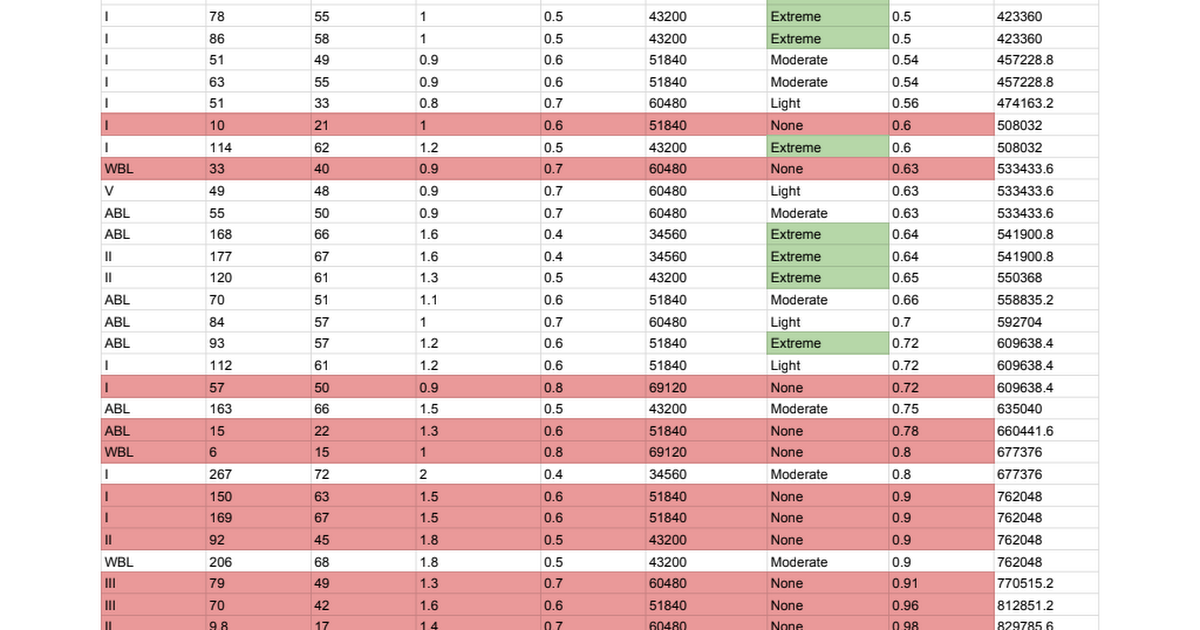OK, I've collected data for 25 of each GG type when I had them. I only have 24 Class IV's, eight Water Giants and six Class V's in my logs with Rotation Periods under .8 days. Here's what I find:
1) The formula of RP*G remains the best method I can derive for determining squishiness, but there is likely a better way. With the R*PG method, the major cutoff points remain .5 and 1.6. 16 of 25 "Extreme" squishies are at or below .5. (Four more fall between .6 and .65. However, their concentration is lessened and .57 is where the "None" bodies begin to creep in). There is only one squishy world out of the 95 above 1.6, which I'll come to below.
2) In what is surely my still limited sample, most squishies are Class I, II, WBL or ABL. This fits with everyone's theories of squishiness being determined primarily by Body Gravity vs. Rotation Period. None of the Water Giants with RP's under .8d in my journals were squishy, but there are only eight of them, and they all fell above the RP*G threshold of 1.6. My sample is likely too small to determine the actual rarity of squishies for any class, but hopefully, this research will aid in doing so.
3) 17 non-squishy bodies fall below the RP*G threshold, ranging from .57 to 1.56. At some point, I noted that in cases of squishiness with relatively high gravity, the Body Radius was always high. This makes sense, given that the further the planet's surface is from its core, the less it is affected by the planet's gravity, making it more susceptible to the centrifugal forces that make them squishy. Non-squishy bodies below the R*PG 1.6 threshold should, therefore, have smaller radii to gravity ratios and lower RP's. Sorting the spreadsheet by Gravity > Radius clearly shows this is the case with these bodies. All of the non-squishies below the threshold that have the same gravity as squishies have the smallest Radii and/or slowest Rotation Periods.

4) I did come across one Class III world with 2195 EM, 73 Mm Radius, 166 Gravity and a .15 RP (3.6 hours) that was moderately squishy. It's R*PG value was 24.9. There are plenty of .2 RP worlds with a fraction of that gravity and radius that are not squishy, and I have no explanation, except that that gravity number must be a glitch in my journal. See, it was the only Class III squishy I came across but was "Unexplored" in the SysMap (a frustratingly common occurrence, since G and RP are two of the stats missing from "unexplored" bodies, but it's apparently in the journal, so it shows up in Observatory! Not a critique; I get that this is an unforeseen use of the app.) so I had to data mine my journal for it's stats. It's body 2 in LTT 10410, in the bubble, if anyone wants to check it out and let me know what's up.

Conclusion:
There is a deeper math and a better method of determining squishiness here that has eluded me thus far. I have attempted various formulas with G/R/EM ratios and RP that have not been successful in sorting the non-squishies; the RP/G method I mentioned previously is now bust. I will be seeking help from anywhere I can with this problem, and it would be awesome if someone here could take up the math as well. I for one will use the R*PG method and take the odds until someone does.

 docs.google.com
docs.google.com
I'm sure it'll be quiet around here for the rest of the week/year, so merry merry and happy happy, everyone!
1) The formula of RP*G remains the best method I can derive for determining squishiness, but there is likely a better way. With the R*PG method, the major cutoff points remain .5 and 1.6. 16 of 25 "Extreme" squishies are at or below .5. (Four more fall between .6 and .65. However, their concentration is lessened and .57 is where the "None" bodies begin to creep in). There is only one squishy world out of the 95 above 1.6, which I'll come to below.
2) In what is surely my still limited sample, most squishies are Class I, II, WBL or ABL. This fits with everyone's theories of squishiness being determined primarily by Body Gravity vs. Rotation Period. None of the Water Giants with RP's under .8d in my journals were squishy, but there are only eight of them, and they all fell above the RP*G threshold of 1.6. My sample is likely too small to determine the actual rarity of squishies for any class, but hopefully, this research will aid in doing so.
3) 17 non-squishy bodies fall below the RP*G threshold, ranging from .57 to 1.56. At some point, I noted that in cases of squishiness with relatively high gravity, the Body Radius was always high. This makes sense, given that the further the planet's surface is from its core, the less it is affected by the planet's gravity, making it more susceptible to the centrifugal forces that make them squishy. Non-squishy bodies below the R*PG 1.6 threshold should, therefore, have smaller radii to gravity ratios and lower RP's. Sorting the spreadsheet by Gravity > Radius clearly shows this is the case with these bodies. All of the non-squishies below the threshold that have the same gravity as squishies have the smallest Radii and/or slowest Rotation Periods.

4) I did come across one Class III world with 2195 EM, 73 Mm Radius, 166 Gravity and a .15 RP (3.6 hours) that was moderately squishy. It's R*PG value was 24.9. There are plenty of .2 RP worlds with a fraction of that gravity and radius that are not squishy, and I have no explanation, except that that gravity number must be a glitch in my journal. See, it was the only Class III squishy I came across but was "Unexplored" in the SysMap (a frustratingly common occurrence, since G and RP are two of the stats missing from "unexplored" bodies, but it's apparently in the journal, so it shows up in Observatory! Not a critique; I get that this is an unforeseen use of the app.) so I had to data mine my journal for it's stats. It's body 2 in LTT 10410, in the bubble, if anyone wants to check it out and let me know what's up.

Conclusion:
There is a deeper math and a better method of determining squishiness here that has eluded me thus far. I have attempted various formulas with G/R/EM ratios and RP that have not been successful in sorting the non-squishies; the RP/G method I mentioned previously is now bust. I will be seeking help from anywhere I can with this problem, and it would be awesome if someone here could take up the math as well. I for one will use the R*PG method and take the odds until someone does.
Oblated Gas Giants
I'm sure it'll be quiet around here for the rest of the week/year, so merry merry and happy happy, everyone!
Last edited:














